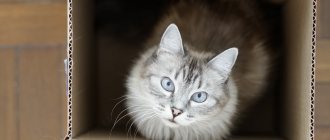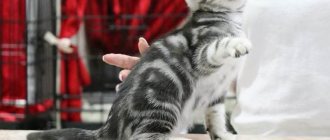Brazilian Shorthairs are domestic cats with a discreet appearance, an independent disposition and a soulful, bewitching gaze. Despite their ordinary exterior and resemblance to yard cats, they are not as simple as they seem.
To understand why Brazilian Shorthairs are so popular in their homeland, let’s look at the characteristics of this breed.
Brief history of the breed
These unremarkable cats simply lived on the streets of Brazil and did not attract the attention of local residents. And it is unknown how their future fate would have developed if professional felinologists had not become interested in them in the 80s of the last century.
Local experts began to select kittens with dominant characteristics of the breed and use them for breeding. As a result, by 1985 they developed the Brazilian Shorthair standard. At the same time, they submitted an application to register a new breed of cats, which remained unsatisfied.
Brazilian cats were combined with their European counterparts and classified as Celtic Shorthairs. But felinologists decided not to give up and continued to prove the uniqueness of the new breed. And in 1999, the WCF organization assigned the Brazilian Shorthair the status of an independent cat variety.
Photo
Let me introduce you – Consuela, a cat from Brazil. The only cat in the world that really sings! At the age of 5, she began to imitate her 17-year-old owner when she practiced vocals. Today she can reproduce notes of the first and second octave, does not go out of tune and is able to sing 36 songs, including the La Traviata aria, compositions by Elvis Presley and even Bach! Consuela can perform both in pairs and solo and successfully tours, poses for photos and appears on posters.
Breed description, standards, appearance
Brazilian Shorthairs are graceful, slender cats with a slightly elongated, strong body and well-developed muscles. All characteristics of the breed are described in the official standard.
Dimensions and weight
The Brazilian cat is an elegant animal with average body parameters. Adult representatives of the breed weigh 3-5 kg. Moreover, cats look a little larger than cats.
Anatomical characteristics
A typical Brazilian cat should fit the following description:
- The head is elongated, of medium size, with a moderately long nose, smooth stop and a strong, slightly protruding chin.
- The ears are straight, regular triangular in shape, set wide apart. Can be decorated with neat tassels.
- The eyes are almond-shaped, slightly slanted, with an intelligent, penetrating gaze. The distance between the eyes is 1.5 times their width. The color of the iris can be any, but must be in harmony with the color of the coat. White Brazilian cats have blue eyes. In silvery individuals, the iris is green or yellow.
- The body is medium in size, rectangular in shape, with a rounded chest and developed muscles. The neck is muscular and strong.
- Limbs of equal length with small round paws.
- The tail is proportional to the body. Wide at the base, gradually tapering towards the tip.
Color and coat type
Brazilian cats have short, close-fitting, silky-to-the-touch fur with no undercoat at all.
The breed standard allows for the existence of any colors, with the exception of point variations.
Possible breed defects
Flaws in appearance that affect a decrease in expert assessment:
- presence of undercoat;
- small stature;
- minor deviations from the standard.
Defects for which the Brazilian Shorthair is subject to disqualification:
- disturbances in the structure of the body;
- lack of claws;
- cryptorchidism;
- deafness.
How to maintain and care
It is necessary to comb the cat every week to remove dead hairs from its fur that could not be accidentally eaten. And, by the way, even if the cat is constantly brushed, she still needs help removing hairballs from her stomach. Not only all clean specimens face this problem. The fact is that over time, wool accumulates in the animal’s stomach. To breed it, specially designed types of feed or special herbs are used.
If the cat is clean, then it takes care of itself. But sometimes it is still worth checking the cleanliness of the ears, as well as the eyes. And it is better to accustom an animal to hygiene procedures from childhood.
Character and temperament
Brazilian cats have an affectionate and calm disposition. They treat all family members well, but do not like to be held. Freedom-loving, moderately talkative Brazilian cats rarely show importunity and calmly tolerate loneliness.
On a note. Although representatives of this breed have an independent character, they need their owner's love and care. Cats left unattended can become irritable and aggressive.
Brazilian Shorthairs get along well with children and willingly take part in outdoor games. But if a child does not know how to handle animals and offends them, then there is a risk that the pet will defend itself with its claws.
Cats of this breed do not conflict with their brothers and good-natured dogs, but do not tolerate rodents near them.
Acquisition
Unfortunately, it is very difficult to buy this cat in the territory of the former Soviet Union. In our countries, this breed is still not popular, and it is almost impossible to find information about the owners of these cats and nurseries. But occasionally you can find advertisements on the Internet where kittens of these cats are sold at a price of 350-500 dollars.
Brazilians have excellent health
If you find an error, please select a piece of text and press Ctrl+Enter.
How to choose the right kitten
Outside of Brazil, there are practically no nurseries that specialize in breeding this breed of cats. Therefore, buying a Brazilian Shorthair can turn into a kind of lottery.
In order not to run into scammers and not to shell out a tidy sum for an ordinary yard kitten, before purchasing an animal you need to make sure that it has documents confirming its origin and vaccinations.
When choosing a pet, you need to pay attention to the following characteristics:
- compliance with breed standards;
- physical activity;
- behavioral characteristics;
- skin and coat condition;
- cleanliness of ears and eyes;
- appetite.
Kitten care
Although Brazilian Shorthair kittens come from the cattery to their owners fully prepared for independent living, they require attention and care. At the initial stage, they are given a little time to adapt, and are also shown where they can eat, sleep and relieve themselves.
In order not to aggravate the stress of a change of environment, at first the little Brazilian is fed what the breeder advised. New foods are introduced into the kitten’s diet gradually. This will allow you to monitor whether they cause stomach upset or allergies. The Brazilian is fed small portions, but often. As you age, the number of meals you eat decreases.
To prevent the kitten from getting injured, wires, household chemicals and small objects are hidden from it in the new house. Also, indoor plants are removed from the little Brazilian, since many of them are poisonous to animals.
Mating
Breeding the Brazilian Shorthair is not easy. Due to the difficulties associated with finding a partner. Brazilians are not popular in Russia, so it will be difficult to find a second parent for future offspring.
If the search is successful, then there will be no problems with the mating process. Traditionally, in the cat world, the cat’s territory is chosen as the meeting place for the couple.
His native walls will give him determination. While the unfamiliar terrain plunges Casanova into shock and the meeting becomes in vain.
Before the meeting, the animals must be prepared. Take him to a veterinarian for deworming. And for safety reasons, trim both claws.
Then the young people are left alone. Natural instincts will help them understand what's what and do their job.
Upon reaching one year, the cat becomes ready to bear offspring. During heat, the usually peaceful and affectionate creature becomes aggressive. He makes noise and is mischievous.
Pregnancy, as a rule, proceeds without complications. Lasts from sixty-two to sixty-eight days. While waiting for the babies, the owners prepare a place for the expectant mother and kittens where they will feel safe.
The Brazilian woman copes with childbirth on her own. But the presence of a veterinarian cannot be called unnecessary. As a result, four to six kittens are born.
The Brazilian Shorthair is one of the kindest, most affectionate and loyal representatives of the cat family. She does not have a unique appearance, but she has a huge heart. Which knows how to love.
Care and maintenance
The Brazilian Shorthair cat does not have an undercoat and does not tolerate dampness and low temperatures. For a comfortable life, she needs a warm and dry room with access to fresh air.
In order for a Brazilian to look neat, he is provided with appropriate hygienic care:
- The cat's eyes and ears are regularly wiped with a dampened cotton swab and inspected for unusual or excessive discharge.
- The claws of the Brazilian Shorthair are trimmed as necessary with a nail clipper so as not to touch living tissue and cause pain to the animal.
- Brush your cat's teeth weekly with a soft brush and a small amount of non-foaming toothpaste.
The coat of the Brazilian breed does not require special care. To maintain an aesthetic appearance, it is periodically combed with a medium-hard brush.
On a note. Brazilian cats do not like water, so in order not to expose the animals to unnecessary stress, they should only be bathed when absolutely necessary.
Where to buy a kitten
It seems that you can only buy a kitten in Brazil, because this breed has not yet become widespread. From time to time, kittens of the Brazilian breed appear on the poultry market, but who can give you a 100% guarantee that you are not being offered offspring from Murka from the next doorway? After all, a characteristic feature (“gaze”) is a rather subjective sign.
There is no specialized nursery for Brazilian cats, but separate nurseries sometimes also deal with Brazilians in parallel with more popular breeds. This gives us hope that Brazilians will take root in our latitudes.
Brazilian shorthair cat. Quem vê cara não vê coração (“He who looks at the face does not see the heart” Brazilian proverb).
Feeding the cat
In order for the Brazilian Shorthair to receive the entire range of vitamins and microelements along with its food, it is advisable to feed it with premium or super-premium drying. A cat of this breed is well suited for the following brands:
- Bosch;
- Royal Canin;
- Pro Plan;
- Pronature.
On a note. A dry-fed Brazilian cat should have easy access to clean drinking water.
With a natural type of feeding, the diet of a representative of the breed is designed so that it contains 70-80% meat. The Brazilian cat is also given fermented milk products, vegetables, cereals, ocean fish and eggs.
In order for the pet to remain healthy and active for a long time, sausages, smoked meats, onions, pork, potatoes, pastries, sweets and any food from the owner’s table are completely excluded from its menu.
If a Brazilian eats natural food, mineral supplements are additionally included in his diet. They are given twice a year, after preliminary consultation with a veterinarian.
Reproduction
Unlike street animals, Brazilian cats, in addition to the spring mating season, also experience a surge in sexual activity in the summer. The heat lasts about a week. Kittens may appear several times a year. During heat, a peaceful and gentle animal can become irritable and even bite or scratch. Since cats are noisy during this period, many people prefer to keep cats. But they have their own characteristics, provoked by instincts: during sexual activity, cats mark their territory with an unpleasant, pungent odor.
The reproductive period in females begins at the age of 1 year, in some individuals - from 8 months. Pregnancy lasts 62–68 days. Before giving birth, owners must prepare a place: for example, a box with bedding. Kittens are born approximately 30 minutes to an hour apart. The cat chews the umbilical cord and licks the cubs. In Brazilian Shorthairs, childbirth usually occurs without complications; the cat is able to take care of itself and the babies.
Newborn kittens are blind and deaf; they begin to see after 15–20 twenty days, and to hear a little earlier. At the age of 3 weeks, babies can be fed. In addition to porridges with milk, boiled finely chopped meat and vegetables are gradually allowed to be introduced into the diet.
An animal with beautiful, intelligent eyes and a good-natured character can become an excellent pet, but, unfortunately, a purebred shorthaired cat can only be found in Brazil; domestic breeders do not breed it. Those wishing to purchase a kitten of this breed can contact clubs where they will tell you how to organize the delivery of a pet from overseas.
For a detailed description of the Brazilian Shorthair cat, see the following video.
Education and physical activity
Brazilian cats are energetic and active animals. Even in adulthood, they will not refuse to chase a ball or a laser pointer. To realize their hunting instincts, they will need several interactive toys. And so that cats of this breed can stretch their muscles, they have a sports corner.
Shorthaired Brazilians are endowed with outstanding mental abilities. Cats of this breed quickly adapt to different conditions and are easy to train. Brazilians not only easily learn basic rules of behavior, but also remember simple commands.
Characteristics of Brazilian cats
These furry cuties can be called universal animals for the home. They combine the best character traits you could wish for in a pet. Playfulness and moderate activity are harmoniously combined with unobtrusive and delicate behavior. Brazilian cats do not single out someone as the main one in the family and willingly play with everyone. They love affection and gentle attitude towards themselves. In response to this, they give the person their love, affection and loyalty.
Single people and large families with children can have four-legged beauties. At the same time, cats pay attention not only to the owners, but also to the guests of the house. They are those very tame cats who love to sit on your lap and rub their fluffy flanks. However, with such gentle notes of character, cats love freedom. That is why walks on the street or in the yard are important for them. If your pet has not yet memorized the way to the house, you can walk it on a leash. The descendants of the Brazilian aborigines from the order of felines calmly tolerate such limitations in movement.
The backyard past is well imprinted in the gene pool of Brazilian shorthair cats . They make excellent mouse hunters, so there are never rodents in the house where they live. Dexterity, speed of reaction, strength and resourcefulness - these are the natural qualities that distinguish colorful beauties.
A description of the Brazilian cat would be incomplete without mentioning their level of intelligence. The mental abilities of these animals are always at their best, which allows them to quickly adapt to changing living conditions and easily navigate a new environment.
Health and susceptibility to disease
The Brazilian Shorthair is an indigenous breed that was formed in natural conditions without human intervention. Thanks to this, cats have good health and live about 15-20 years. They are not prone to serious hereditary pathologies and are little susceptible to infectious diseases.
On a note. Practice shows that in rare cases, Brazilians experience problems with the skin and digestive system. But all of them are caused by poor nutrition and can be treated.
Health
The Brazilian Shorthair is a native cat breed. Natural selection has done its job. Representatives of the family can boast of excellent immunity and good health. And also the absence of genetic diseases.
Nature, for its part, has done an excellent job, but people can ruin everything. Due to improper nutrition, the animal may develop problems with the fur, skin or gastrointestinal tract.
Brazilian women have one drawback, or rather a bad habit. Put everything in your mouth that is not nailed down. It is due to the fact that for a long time representatives of the breed lived on the streets and ate everything that even slightly resembled food.
The problem is still relevant, so animals need to be regularly checked for parasites. The main signs of infection are:
- Cough;
- Apathetic state;
- Sudden weight loss;
- Bloating;
- Patchy baldness;
- Problems with stool.
Self-medication can do more harm than good. Therefore, if you have at least one of the symptoms listed, you should immediately consult a veterinarian.
With proper care, timely vaccinations and proper nutrition, the pet will live long and happily. About twenty years. Brazilian Shorthairs are long-lived cats.
Vaccinations
A strong immune system is, of course, great. However, no one has canceled preventive vaccinations. You definitely need to do them!
Vaccination begins at an early age. You must first make sure that the baby is absolutely healthy. The veterinarian must inspect and interview the owner. In addition, before each vaccination procedure, the animal must be dewormed.
The first vaccination is given to a kitten at six to eight weeks. Thirty days later the procedure is repeated. Next, the veterinarian draws up an individual vaccination schedule based on the pet’s characteristics.
Pros and cons of the breed
Brazilian cats, like representatives of any other breed, have not only advantages, but also disadvantages:
| pros | Minuses |
| Good health | Rarity of the breed |
| Good character | |
| Low maintenance |
Brazilian Shorthairs are animals that can easily be confused with their outbred relatives. But their developed intelligence, good health, excellent character and high adaptability make them almost ideal companions.
Photo gallery
Below are photos of Brazilian Shorthair cats.
tocadatigresa
aplcfernanda
tigri.nho
alinejobrebelscum
gata_mel2477
gata_mel2477
What to feed your Brazilian Shorthair?
If you choose between a large number of feeds, then you should give your preference to premium food. Such cats are not at all picky, and even if you offer them simpler food, they will not refuse it. But is it worth it, because the health of your pet is much more important.
You can also feed your cat natural food, which includes meat along with dairy products. It is better to exclude any fresh fish from the diet, because through it you can become infected with worms.
It is worth taking care of your pet and not feeding it chicken skin or starchy vegetables, because, as experienced breeders note, not all cats have a digestive system in good condition. It is also not permissible to give red vegetables to animals of this breed. The cat's gastrointestinal tract is not able to digest such food.
laperm - description of the breed and character of the cat
Complete nutrition for exotic pets
Brazilian cats are omnivores, they eat the same way as other domestic animals, which is explained by the conditions of their origin, and adapt well to natural food - fermented milk products and meat. Raw river and sea fish can lead to infection with worms, so it is excluded from the pet’s diet. In addition, breeders advise not to feed these cats chicken skins and vegetables with a high concentration of starch, as there may be problems with the gastrointestinal tract. If you choose ready-made food, then take a premium one, but it is better to consult a veterinarian. During molting and pregnancy, a complex of vitamins is added to the menu to maintain normal functioning of the body.
Description
It is a large cat, although often described as small and gentle. However, the owners say that they can weigh from 5 to 8 kg! It differs from the American Shorthair by its more elegant appearance and high agility. On the contrary, Siamese cats have a stronger build.
The coat is short and thick, lying tightly. The color of the coat is extremely varied, as is the presence of stripes and spots on it.
The eyes are large and widely spaced and are a distinctive feature of the Brazilian cat. They are very smart and expressive, their color intersects with the color of their coat, and they are almond-shaped.
The tail is of medium length, thin, slightly tapering towards the end.











